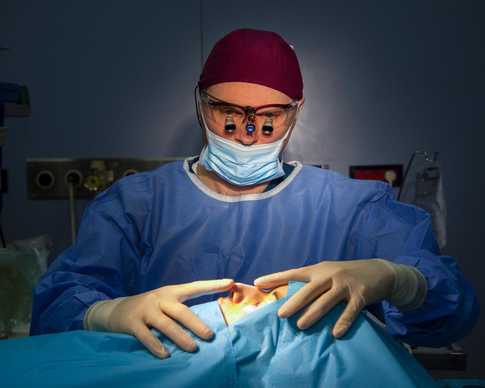Risks during plastic surgery on the nose
Every operation involves risks. In the case of rhinoplasty, these can include the following.
- The most common minor side effect, which can occur in all rhinoplasty operations, is bleeding. There is always a little bleeding postoperatively and it almost always stops on its own. However, there is a very small risk of a heavy nosebleed. This can occur up to 10 days after the operation.
- Risks associated with anesthesia. At VIP Rhinoplasty, our anesthesiologists are part of a permanent and highly experienced team and are able to anticipate and deal with any anesthesia-related issue during the operation.
- Infection during healing. As a precaution, we prescribe our patients antibiotics for three to four days to guard against this eventuality.
- Poor healing of wounds or unsightly scars. By following the proper microsurgical technique and using high-quality sutures and instruments, we ensure the best possible healing and the avoidance of unsightly scars.
- A change in skin sensation (numbness or higher sensitivity). A change in skin sensation is to be expected for a while, particularly around the tip of the nose. The proper technique for opening and closing a wound ensures that the problem will lessen a few weeks after the operation and will eventually disappear completely.
- Perforation of the nasal septum is a rare occurrence that can be repaired with a second operation. The risk is minimized when the patient follows our postoperative instructions properly.
- Discoloration of the skin and swelling. Postoperative swelling takes time to go down and requires patience before the final results of the operation can be seen. This may take up to a year in cases where the skin around the nose is thick and sebaceous (oily).
- Possible need for revision surgery. In cases of postoperative injury, excessive pressure on some parts of the nose or inadequate postoperative care, a second operation may be required. In a small number of cases, a minor procedure may also be necessary to correct a problem such as the post-operative adhesions (synechia) that can be created when the post-op instructions regarding nasal rinsing have not been followed properly and regularly.
- Unsatisfactory
appearance. This
is obviously relative, as it depends on the patient’s expectations after consultation
with the surgeon. At VIP Rhinoplasty, we use 3D imaging to reduce the
possibility of any misunderstanding between patient and surgeon regarding what
the surgery will involve and the anticipated result.
Possible postoperative risks and complications
In addition to the above risks, you may have to deal with some minor side effects while your post-rhinoplasty nose is in the process of recovery.
Of course, every patient is different, so you may well experience none of these side effects.
- There is no pain after a rhinoplasty operation using Piezosurgery. However, because we are dealing with bone and cartilage and not just skin, patients may feel a small amount of discomfort while the area is in the process of recovery. It is worth noting that most patients describe a sensation of pressure rather than pain. Some patients choose to take a simple painkiller which is enough to solve this problem.
- Swelling around the eyes and nose is also quite normal and largely disappears after about two weeks. It is important to bear in mind that a small amount of swelling may continue for six months to a year after the operation because of the increased sensitivity of the area.
- Bruising is also a very common side effect that depends on your sensitivity to the surgery, your skin, and the extent of the surgery itself. It usually appears around the eyes and nose and can last for up to 10 to 15 days. This is considered quite normal after a rhinoplasty surgery.
- Scars appear after rhinoplasty, although they are rarely visible. In closed rhinoplasty, for example, an incision is made inside the nostril, so the scars are completely hidden. Open rhinoplasty involves a small incision in the skin between the two nostrils. This heals extremely well and is not noticeable, while we also provide you with a special ointment to make the healing process even easier.
- Permanent external scars rarely remain, and when they do, they are minimal and inconspicuous. However, surgery is never 100% predictable, so it is wise to be realistic.
- Could we say 'they are rarely visible' or is that stretching the truth?
During your recovery, it is important for you to monitor the operated area for any changes or abnormalities.
If you have any cause for concern that we haven't already informed you about and is not covered in the information you have been given, you should let us know. If any care is required, Dr. Mireas will give you the appropriate instructions.
Postoperative care: what the patient should be aware of
At VIP Rhinoplasty, we always give detailed written instructions about the postoperative period, describing what to monitor and what exactly to do to ensure the best and fastest recovery. It is very important to follow these instructions to the letter for as long as necessary.
Dr. Mireas considers the information in these instructions just as important as your visit and your discussion with him in ensuring that you have the best possible results and the most relaxed postoperative period.
Our patients usually recover quickly and painlessly, and are back to their normal activities in next to no time.

